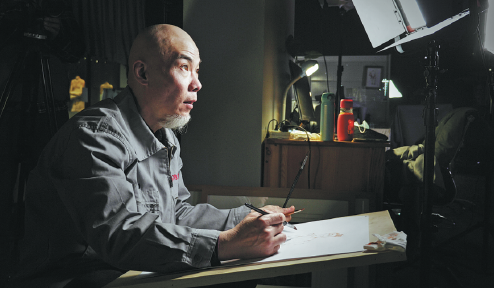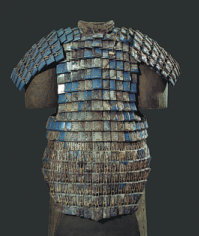Relic restorer brings the 'dead' back to life

Ma Yu is a skilled craftsman, more like a surgeon that brings the dead back to life.
Every day, the 49-year-old works hard to restore damaged relics to their original state, some of which were just fragments when they were dug up.
He's a relic restorer at the Emperor Qinshihuang's Mausoleum Site Museum in Xi'an, capital of Northwest China's Shaanxi province and home to the world-famous Terracotta Warriors.
Discovered in 1974, the sculptures were buried beside the first emperor of a unified China, Qinshihuang, founder of the Qin Dynasty (221-206 BC). Archaeologists have excavated three major sites with a total area of over 20,000 square meters, which contain nearly 8,000 life-size clay figures and horses.
"Life is but a short span. I want to leave something valuable for later generations, and my work will be duly evaluated," said Ma, who has worked at the museum for 29 years.
"Our restoration is more like a second archaeological excavation. We seek to reveal information the ancient craftspeople left on these cultural relics."
Since 2012, he has been in charge of the restoration of the 9901 Pit at the mausoleum, which contains over 30 terracotta figures in various poses that are believed to be performers entertaining the emperor.
When Ma accidentally found a partial fingerprint on a fragment of the terracotta figures, and a few more prints later, which were probably unintentionally left by craftspeople over 2,000 years ago, criminal investigation experts were able to extract information from them such as gender and age.
"The preservation and restoration of cultural relics is an interdisciplinary field. I often work with chemists, archaeologists, material experts and historians, who help me solve various professional problems," he said.
He said the number of usable fingerprints is limited because they have to be both clear and complete. So far, they've only been found on eight terracotta figures and belong to different people.
Current information shows they were aged no more than 35, and that the youngest was about 15. A group of triple fingerprints probably belonged to a woman.
Ma likes the challenge of repairing cultural relics, each of which takes at least a year to complete.
Among them, his favorite is the No 25 Bronze Red-crowned Crane, which was discovered in 2000, with its beak, neck and feathers badly damaged.
"It showcases the wisdom of Qin Dynasty craftspeople. The bronze crane and its lifelike three-dimensional feathers are decorated in colored patterns," he said.
The terracotta figures were originally decorated in different colors, which have largely faded and been absorbed by the earth that surrounded them after excavation. The biggest difficulty is restoring these colors. Ma has experimented to figure out how the ancient craftspeople made the clay figures, so that he can choose a suitable adhesive.
It's time-consuming work. He's established archives for each fragment and relic, which includes detailed information on their size, weight and state of preservation.
"Slow work yields fine results. National policy in recent years has attached great importance to archaeology, making it easier for us to take the time to do our work," he said.
He requires all team members to draw up sketches of the cultural relics to be restored and to have a deep understanding of the relics during the process. This helps them decide which method and solvent should be used in cleaning, which differs from situation to situation.
"Each relic represents a different culture. It's just like people wearing different clothes in different years. I often use the excavation reports to figure out the characteristics of the relics of a certain period of history," he said.
Ma's late father was among the first batch of workers at the museum. He created the museum's Terracotta Warrior reliefs and made miniatures of clay figures and horses that are sold as souvenirs.
Quietly influenced by what he watched his father do as a child, Ma decided to follow in his footsteps when the museum was recruiting restorers in 1992.
Four years later, he was chosen to join a two-year training course in Xi'an, sponsored by the Italian government and taught by Italian professionals, about European theories and techniques of relic restoration.
He still remembers when a student in the class accidentally kicked a fragment. The teacher suddenly became angry and told the student that "cultural relics are nonrenewable resources. Any careless action or mistake may lead to serious consequences".
It was from this training that Ma learned the importance of respecting the relics. He said that since foreign theories have been introduced to China through international cooperation, the country has benefited greatly from the rich experience of others.
"A relic restorer should revere cultural relics and do their best at work. If you accidentally damage one during repair, you cannot restore it to its previous state-it's like a medical accident has happened, and you can do nothing to make it up," he said.
Ma currently leads a team of seven people and has overseen 20 others who have left the discipline in the past nine years.
"It's energy-consuming to train a restorer, as it takes at least three years. You have to first plant the definition of a cultural relic in their mind and then improve their professional skills," he said.
Many have quit because restoration is a laborious job with a relatively low income. But he said pay and benefits have been raised in recent years, and the general public has come to know more about the profession.
Some Chinese universities have established majors in relic restoration to ensure a supply of qualified individuals in future. Ma said they are always badly needed and hopes that more young people will take up the career.
xulin@chinadaily.com.cn























